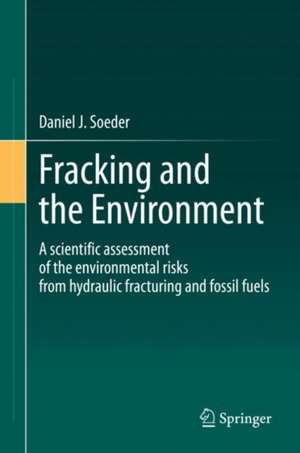Fracking and the Environment: A scientific assessment of the environmental risks from hydraulic fracturing and fossil fuels
Autor Daniel J. Soederen Limba Engleză Hardback – 11 noi 2020
The intended audience is scientific people who are concerned about fracking, but perhaps do not know all that much about it. It is also intended for lay people who would be interested in understanding the technical details of the process and what effects it might or might not be having on the environment. The book is written at a level that is both understandable and technically correct. A further goal is to give some useful insights even to experienced petroleum geologists and engineers who have been doing fracking for many years.
Preț: 785.55 lei
Preț vechi: 957.99 lei
-18% Nou
Puncte Express: 1178
Preț estimativ în valută:
150.31€ • 157.36$ • 124.38£
150.31€ • 157.36$ • 124.38£
Carte disponibilă
Livrare economică 17-31 martie
Preluare comenzi: 021 569.72.76
Specificații
ISBN-13: 9783030591205
ISBN-10: 3030591204
Pagini: 279
Ilustrații: XXII, 279 p. 44 illus., 36 illus. in color.
Dimensiuni: 155 x 235 mm
Greutate: 0.54 kg
Ediția:1st ed. 2021
Editura: Springer International Publishing
Colecția Springer
Locul publicării:Cham, Switzerland
ISBN-10: 3030591204
Pagini: 279
Ilustrații: XXII, 279 p. 44 illus., 36 illus. in color.
Dimensiuni: 155 x 235 mm
Greutate: 0.54 kg
Ediția:1st ed. 2021
Editura: Springer International Publishing
Colecția Springer
Locul publicării:Cham, Switzerland
Cuprins
Chapter 1: Introduction: What is Fracking?.- Chapter 2: The History of Oil & Gas Development in the United States.- Chapter 3: Fracking and Air Quality.- Chapter 4: Fracking and Water.- Chapter 5: Effects on Landscapes and Habitats. - Chapter 6: Impacts to Ecosystems and Human Health. - Chapter 7: Fossil Fuels and Climate Change. - Chapter 8: Mitigation and Remediation.- Chapter 9: Balancing Energy, Environment, and Economics.
Notă biografică
Daniel J. Soeder is a consulting geologist and writer. He served as Director of the Energy Resources Initiative at the South Dakota School of Mines & Technology, as a research scientist for the U.S. Department of Energy, and as a hydrologist for the U.S. Geological Survey. His research interests include the geology of conventional and unconventional oil and natural gas reservoirs, environmental effects of fossil energy production, and the petrophysical properties of geologic materials, including low-permeability sedimentary, igneous, and metamorphic rocks
Textul de pe ultima copertă
This book provides a systematic scientific approach to the understanding of hydraulic fracturing (fracking) as a hydrocarbon extraction technology and its impact on the environment. The book addresses research from the past decade to assess how fracking can affect air, water, landscapes and ecosystems, and presents the subject in the context of the history of fracking and shale gas development in the United States, describing what is known and not known about environmental impacts, and the broader implications of fossil energy use, climate change, and technology development. In 9 chapters, the author lays out how and why hydraulic fracturing was developed, what driving forces existed at the beginning of the so-called "shale revolution", how success was achieved, and when and why public acceptance of the technology changed.
The intended audience is scientific people who are concerned about fracking, but perhaps do not know all that much about it. It is also intended for lay people who would be interested in understanding the technical details of the process and what effects it might or might not be having on the environment. The book is written at a level that is both understandable and technically correct. A further goal is to give some useful insights even to experienced petroleum geologists and engineers who have been doing fracking for many years.
The intended audience is scientific people who are concerned about fracking, but perhaps do not know all that much about it. It is also intended for lay people who would be interested in understanding the technical details of the process and what effects it might or might not be having on the environment. The book is written at a level that is both understandable and technically correct. A further goal is to give some useful insights even to experienced petroleum geologists and engineers who have been doing fracking for many years.
Caracteristici
Provides a scientific approach to the understanding of hydraulic fracturing (fracking)
Discusses fracking in a historical context to give insights into its present-day uses and impacts
Offers a systematic approach to understanding and preventing environmental impacts of fracking
Discusses fracking in a historical context to give insights into its present-day uses and impacts
Offers a systematic approach to understanding and preventing environmental impacts of fracking
